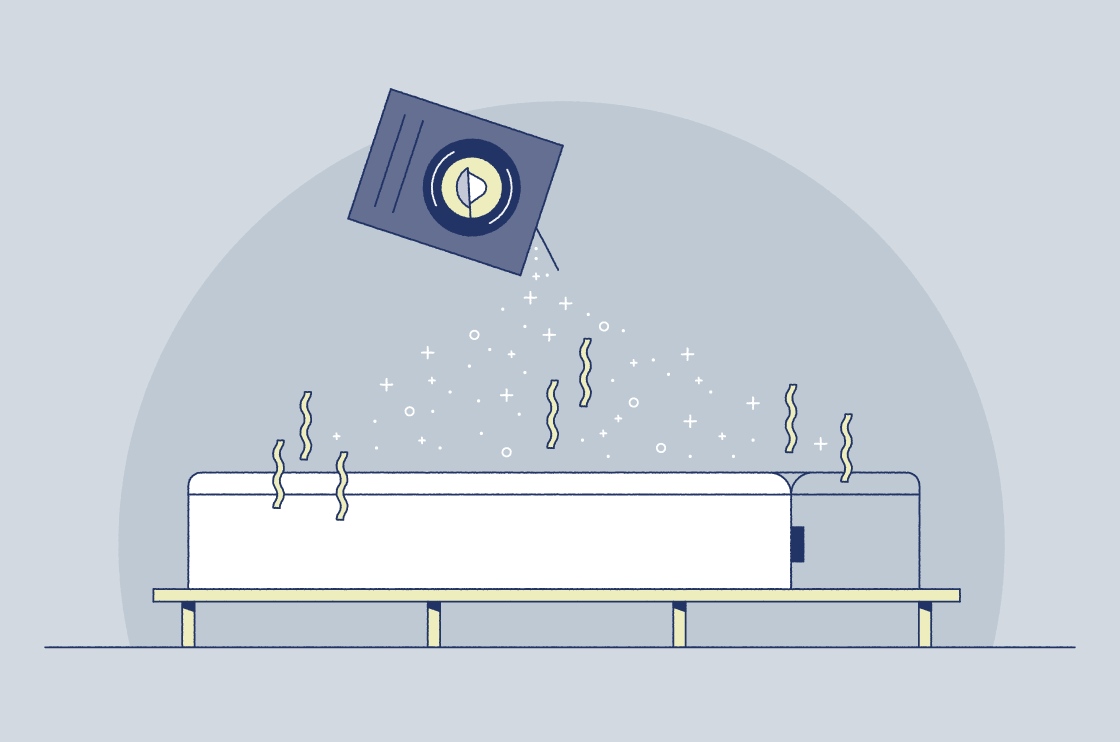When choosing a mattress for a child, prioritize the right size for their age and room, a safe and supportive material, and an appropriate firmness for their sleep position. Ensure it’s durable, certified non-toxic, and fits their bed frame and space.
When it comes to providing your child with the best start each day, sleep is non-negotiable. A supportive mattress tailored to your young sleeper’s needs is a crucial step in fostering healthy growth, development, and energy levels. If you’re wondering how to choose a mattress for a child, this guide will help you navigate the key factors to consider, the ideal mattress types, and why Casper is your ultimate choice.
Key Factors to Consider When Choosing a Mattress for a Child

Mattress Size
Selecting the right mattress size is essential to ensure your child has ample space to sleep comfortably while also fitting your home’s layout. Kids’ sleep patterns evolve as they grow, and their mattresses should be able to accommodate these changes over time.
Crib and Toddler Mattresses
For infants and toddlers, safety and support come first. Crib mattresses typically measure 28 inches wide by 52 inches long and should be firm to ensure safe sleep. They should fit snugly within the crib to reduce the risk of injury or entrapment.
As your child grows, transitioning to a toddler mattress typically happens between 18–36 months. Toddler mattresses often match crib dimensions but may be paired with a toddler bed frame for a smoother transition. Opt for a mattress with durable materials that can handle your kid’s nightly adventures while maintaining proper spinal alignment. A quality mattress also makes the milestone of moving out of the crib feel exciting and secure for your child.
Standard Mattress Sizes for Children
For older children, twin, twin XL, and full sizes are common choices. Understanding the dimensions and benefits of each size can help you make an informed decision:
- Twin: Measures 38 inches wide by 75 inches long. Ideal for younger children or compact rooms, this size is perfect for kids who sleep alone and don’t need much room to spread out.
- Twin XL: Measures 38 inches wide by 80 inches long. This option provides extra length for growing kids, making it a great choice for taller children or teenagers who need additional legroom.
- Full: Measures 54 inches wide by 75 inches long. A versatile option offering ample sleeping space, this size works well for older kids or children who share their bed with pets or occasional guests.

When choosing, consider your child’s growth patterns. Twin and twin XL mattresses work well for younger children, while full-size mattresses can better accommodate those who love to spread out. Opting for a larger size may also be a better long-term investment than a twin-size mattress, especially for growing kids. Check out our blog to learn even more about comparing twin vs full mattress sizes.
Room Size and Mobility
A good mattress doesn’t just fit your child—it should fit the room, too. Compact rooms may benefit from a twin or twin XL mattress, while larger bedrooms allow for full sizes. If your child shares a room or if you’re short on space, bunk beds are an excellent solution. Just make sure the bunk bed mattress size is correct and meets the safety requirements for thickness and firmness.
For families who move frequently, a lightweight mattress, such as a memory foam or hybrid option, can make transitions easier. Mobility matters when rearranging furniture or moving into a new space.
Mattress Materials
The material of your child’s mattress can impact its comfort, support, and durability. Understanding the different mattress materials ensures you choose one that aligns with your child’s sleeping habits and preferences.
Innerspring Mattresses
These feature steel coils that provide bounce and support. Innerspring mattresses are breathable and durable, making them a classic choice for active young sleepers. They are ideal for back sleepers or stomach sleepers who need firm support to maintain proper alignment.
Memory Foam Mattresses
Memory foam mattresses, like the One affordable mattress from Casper, contour to the body, offering excellent pressure relief for side sleepers. These mattresses are especially beneficial for kids who shift positions during the night, as the foam adjusts to their movements, minimizing sleep disruptions. For parents concerned about safety, look for CertiPUR-US-certified options, which ensure the foam is free of harmful chemicals.
Latex Mattresses
A latex mattress combines durability with natural materials, making it ideal for environmentally conscious families. Latex mattresses are hypoallergenic and supportive, suiting kids with allergies or sensitive skin. They also provide a firmer surface, which is great for back sleepers.
Hybrid Mattresses
Blending innerspring coils with memory foam or latex layers, a hybrid mattress like the Dream offers the best of both worlds. They provide the responsive support of innerspring systems with the contouring comfort of foam or latex, making them a versatile choice for a variety of sleeping positions.
Firmness Levels for Kids
Mattress firmness levels greatly impact a child’s comfort and spinal alignment. It’s all about finding the balance between softness and support based on age and sleeping position. Many parents mistakenly believe softer is better, but too much softness can compromise spinal health, especially for children’s growing bodies that need the support.
Matching Mattress Firmness to Sleep Position
- Side Sleepers: Softer surfaces help cushion pressure points like hips and shoulders, promoting comfortable sleep without aches.
- Back Sleepers and Stomach Sleepers: Firmer mattresses ensure proper spinal support, reducing the risk of aches and pains. Stomach sleepers especially need firmness to prevent sinking, which could strain the back and neck.
Age-Appropriate Firmness
As your child grows, their firmness needs may change. Young sleepers benefit from firmer mattresses, which promote spinal alignment and support developing bodies. For older kids, consider a mattress with medium-firm support to balance comfort and durability. Choosing a firmness level that grows with your child ensures you won’t need to replace the mattress prematurely.
Learn more about a firm vs medium mattress in our blog.
Safety Features
Safety is a top priority when mattress shopping for kids. Look for these certifications to ensure your child’s sleep environment is free from harmful chemicals and allergens.
Certifications to Look For
- CertiPUR-US: Guarantees foam is made without ozone depleters, formaldehyde, or heavy metals.
- OEKO-TEX® Standard 100: Ensures textiles are tested for harmful substances, making the mattress safe for sensitive skin.
- GOLS/GOTS: Indicates organic materials in latex or fabrics, ideal for eco-conscious families.
- Greenguard Gold: Certifies low chemical emissions, improving indoor air quality for healthier sleep.
Special Considerations for Bed Frames
If your child uses a bunk bed or trundle, check the mattress thickness. Many bunk beds recommend mattresses no thicker than 6-8 inches to ensure safety rails work effectively. Similarly, trundle frames often require slimmer profiles to allow smooth operation.
Additional Considerations
Durability and Longevity
Children grow quickly, and their mattress should grow with them. High-density foam, robust innerspring coils, or durable latex can withstand years of wear and tear. Hybrid mattresses strike a great balance between comfort and longevity.
Trial Periods and Warranties
Kids can be picky sleepers, so a trial period allows you to test the mattress risk-free. Casper offers a 100-night sleep trial to ensure the mattress meets your child’s needs. Warranties provide peace of mind, protecting your investment against defects or premature wear.
Buying Online vs. In-Store
Online mattress shopping offers convenience and a broader selection, while in-store visits allow you to test mattresses in person. Casper combines the best of both worlds. Visit a Casper Sleep Shop near you.
Why Choose Casper Mattresses for Your Child?
Casper mattresses are designed with your growing kid in mind, blending science-backed innovation with the cozy comfort children love. Here’s why Casper is the best mattress for your young sleeper:
- Safety First: With certifications like CertiPUR-US and OEKO-TEX®, our mattresses meet the highest safety standards.
- Perfect Comfort: Whatever support and size your child needs, Casper’s diverse range has you covered.
- Durable and Long-Lasting: Our mattresses are built to endure everything from bedtime stories to midnight jumping sessions.
- Trial Period and Warranty: Our sleep trial and warranty make it easy to find the right mattress risk-free.
Choosing the right mattress for your child is about more than just sleep—it’s an investment in their overall well-being. With Casper, you’re not just buying a mattress; you’re setting your child up for brighter mornings and healthier tomorrows.
Ready to find the perfect mattress for your young sleeper? Start with Casper today.

Reviewed By
Jonathan Eilenberg is a Certified Professional Ergonomist (CPE) with a degree in Design and Environmental Analysis from Cornell University, specializing in Human Factors and Ergonomics. His expertise in biomechanics and ergonomics has significantly contributed to improving workplace productivity and comfort. With over six years in occupational injury prevention, Jonathan now applies his knowledge at Casper, developing biomechanically supportive mattresses, emphasizing proper sleep posture to enhance comfort and recovery. His work integrates ergonomic principles into everyday life, aiming to improve physical well-being through thoughtful design.










